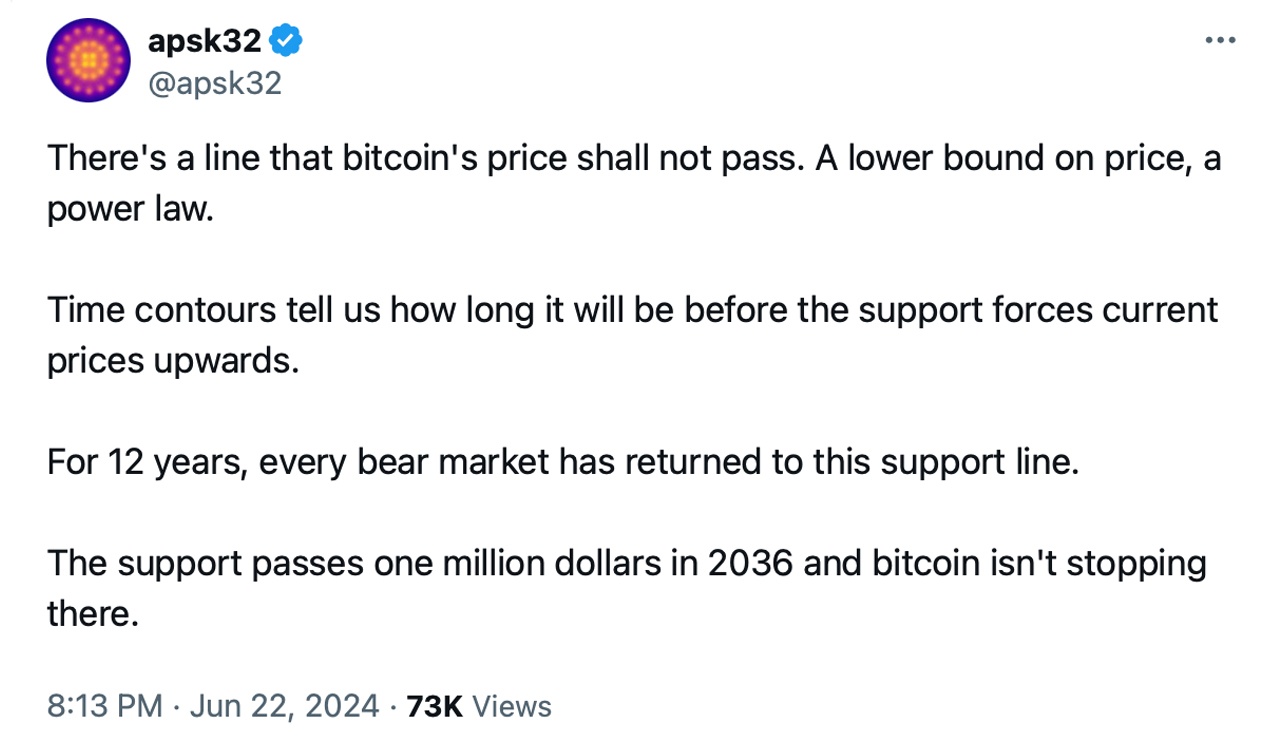In 2020 and early 2021, the stock-to-flow (S2F) bitcoin price model captured widespread attention. Although bitcoin currently stands over 13% below its peak value reached in March, the Power Law Corridor model has become increasingly influential. Many hold the view that the Power Law model’s support line has remained steadfast for over ten years and foresee that BTC could eventually reach six to seven-digit values, provided it consistently holds its course.
Bitcoin Analysts Foresee a Seven-Digit Future in Power Law Theories, But Not Everyone Is Convinced
Plan B’s stock-to-flow (S2F) model once garnered significant attention, and recently, it has experienced a mild revival in interest. Nevertheless, the Power Law Corridor model has gained greater prominence in recent times, with theories about the Power Law and bitcoin (BTC) now prevalent across forums and social media platforms. On Saturday, John Osterman explored the purported support lines of the Power Law.
“The bitcoin Power Law has NO concept of timing the market,” Osterman remarked on X. “It’s just the floor. There is no getting burned with knowing that the floor/ support is there and it keeps rising. If you think that the bitcoin price will NOT go below the red support line, CONGRATULATIONS, you are a believer in the bitcoin Power Law model,” he added.
Bitcoin.com News has reported on the Power Law theory on multiple occasions. Fundamentally, the Power Law or Power Law Corridor theory posits that certain financial phenomena, such as bitcoin’s price dynamics, adhere to a mathematical relationship where large occurrences (like significant price shifts) are rarer but carry more weight than smaller, more common ones.

According to this theory, asset prices generally adhere to a corridor that follows a power law distribution, meaning the probability of extreme price shifts reduces but remains possible as the values move away from the average. Essentially, BTC’s price movement aligns with a Logarithmic Growth Curve, usually maintaining its path within these predefined curved boundaries.
In the first week of March 2024, Bitcoin.com News highlighted a formula proposed by bitcoin enthusiasts Fred Krueger and Giovanni Santostasi. Using a Power Law equation, they predicted that BTC might escalate to $1 million per coin by 2033. Despite BTC reaching a dramatic peak of $73,794 on March 14, 2024, discussions around Power Law theories persist. “Bitcoin Power Law Support has held strong for the last 15 years,” the X account Plan C said on June 22. The analyst added:
It has weathered the 2020 crash, the Luna collapse, the FTX scandal, and more. Assuming it continues to hold, these would be the lowest prices we could expect. Power Law Support = 0.03 Quantile Regression.
Not everyone is convinced by the Power Law theory, and an X account named Wicked warned that relying on the theory could lead to disappointment. “A lot of people are gonna get f***ed this cycle by putting too much credence into the bitcoin Power Law model and trying to time bottoms,” Wicked wrote. “My strategy will remain unchanged … hold minimal (zero if possible) fiat and simply save everything in bitcoin as soon as it’s earned.”
“Bitcoin Power Law model is amazing,” another individual said. “The Line of Friendship is the ‘bear market floor.’ However, just be careful of trusting these … every model eventually gets broken. But it’s nice to dream of the straight line.”
What do you think about the bitcoin Power Law price model? Share your thoughts and opinions about this subject in the comments section below.
 news.bitcoin.com
news.bitcoin.com
